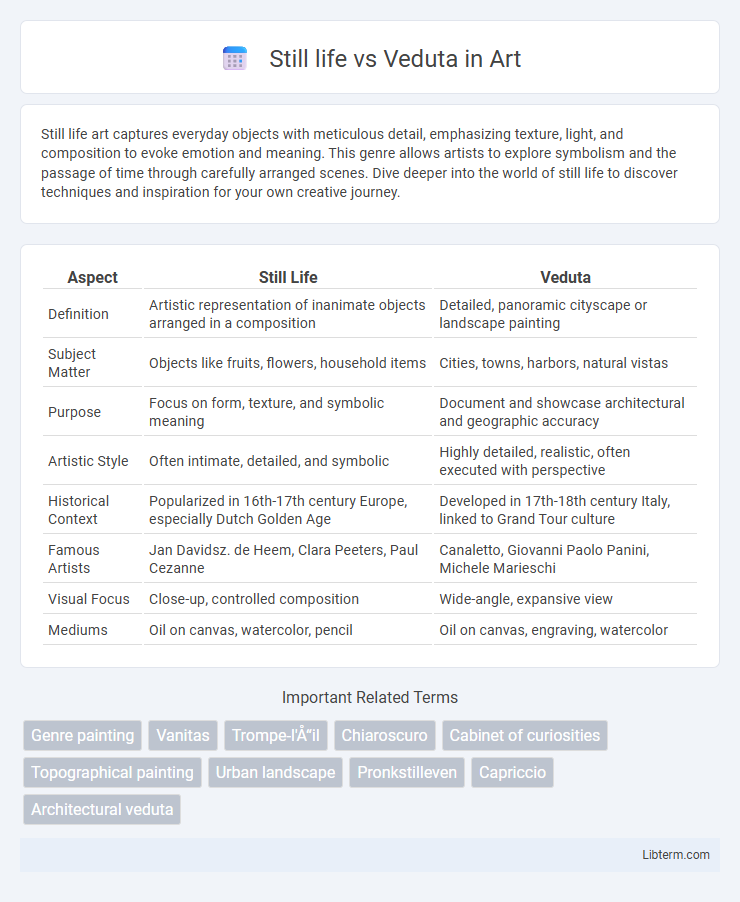Still life art captures everyday objects with meticulous detail, emphasizing texture, light, and composition to evoke emotion and meaning. This genre allows artists to explore symbolism and the passage of time through carefully arranged scenes. Dive deeper into the world of still life to discover techniques and inspiration for your own creative journey.
Table of Comparison
| Aspect | Still Life | Veduta |
|---|---|---|
| Definition | Artistic representation of inanimate objects arranged in a composition | Detailed, panoramic cityscape or landscape painting |
| Subject Matter | Objects like fruits, flowers, household items | Cities, towns, harbors, natural vistas |
| Purpose | Focus on form, texture, and symbolic meaning | Document and showcase architectural and geographic accuracy |
| Artistic Style | Often intimate, detailed, and symbolic | Highly detailed, realistic, often executed with perspective |
| Historical Context | Popularized in 16th-17th century Europe, especially Dutch Golden Age | Developed in 17th-18th century Italy, linked to Grand Tour culture |
| Famous Artists | Jan Davidsz. de Heem, Clara Peeters, Paul Cezanne | Canaletto, Giovanni Paolo Panini, Michele Marieschi |
| Visual Focus | Close-up, controlled composition | Wide-angle, expansive view |
| Mediums | Oil on canvas, watercolor, pencil | Oil on canvas, engraving, watercolor |
Introduction to Still Life and Veduta
Still life and veduta are distinct genres of painting with unique characteristics and historical significance. Still life focuses on the detailed depiction of inanimate objects such as fruits, flowers, and household items, emphasizing composition, light, texture, and symbolism. Veduta, originating from Italian tradition, involves highly detailed, often panoramic views of cityscapes or landscapes designed to capture architectural accuracy and spatial perspective.
Historical Origins of Still Life
Still life paintings originated in ancient Egypt and classical antiquity, gaining prominence during the Renaissance as artists explored realism and symbolism through carefully arranged inanimate objects. These compositions often featured food, flowers, and everyday items, symbolizing themes like mortality and abundance. In contrast, Veduta paintings emerged in 16th-century Italy, focusing on highly detailed cityscapes and landscapes that captured architectural accuracy and urban life.
The Emergence of Veduta in Art
Veduta emerged in the 17th century as a detailed, large-scale cityscape genre capturing urban vistas with precise architectural accuracy, contrasting the traditionally intimate and symbolic nature of still life paintings. This shift reflected growing urbanization and travelers' demand for visual souvenirs, leading artists to emphasize perspective, light, and atmospheric effects in vedutas, unlike the static composition and focus on inanimate objects in still life. The genre's popularity peaked in Venice, with artists like Canaletto pioneering veduta and influencing landscape painting by integrating documentary precision and artistic expression.
Key Characteristics of Still Life
Still life art centers on inanimate objects, emphasizing texture, light, and composition to capture realism and symbolic meaning. Common subjects include fruits, flowers, vessels, and everyday items, arranged to explore themes of mortality, beauty, and abundance. The meticulous detail and controlled setting in still lifes contrast with the expansive, detailed landscapes characteristic of veduta paintings.
Distinct Features of Veduta
Veduta is characterized by highly detailed, large-scale cityscapes or landscapes, emphasizing architectural accuracy and panoramic views, often capturing urban landmarks and bustling scenes with precise perspective. Unlike still life, which centers on inanimate objects arranged in an intimate setting, veduta aims to document real-world locations, blending artistic interpretation with topographical fidelity. The use of natural light, shadow, and meticulous spatial composition are essential to evoke realism and the grandeur of the depicted environment.
Subject Matter: Objects vs. Landscapes
Still life paintings emphasize the detailed depiction of inanimate objects such as fruits, flowers, and everyday items, showcasing texture, form, and light. Veduta art centers on expansive landscapes or cityscapes, capturing architectural landmarks and natural vistas with precision and panoramic scope. The subject matter of still life isolates intimate, static compositions, while veduta highlights broad, dynamic environmental scenes.
Techniques in Still Life Painting
Still life painting employs techniques such as chiaroscuro to create depth and highlight textures, alongside meticulous brushwork that captures intricate details of objects, emphasizing their material qualities. Artists utilize controlled lighting and composition to convey symbolism and evoke emotional resonance within ordinary items. The layering of glazes enhances color richness and creates a realistic or luminous effect that distinguishes still life from the architectural precision seen in veduta paintings.
Perspective and Realism in Veduta
Veduta paintings emphasize precise linear perspective and meticulous detail to create highly realistic urban or landscape scenes, capturing the spatial depth and architectural accuracy of a location. Unlike still life, which focuses on the arrangement of objects to explore composition and texture, veduta aims to represent real-world views with photographic clarity and a sense of place. This pursuit of realism in veduta relies heavily on techniques such as vanishing points and foreshortening to convey three-dimensional space on a two-dimensional canvas.
Cultural Contexts and Artistic Intent
Still life paintings historically reflect intimate cultural contexts emphasizing everyday objects to symbolize themes like mortality and wealth, often serving as meditative or moral reminders within domestic spaces. Veduta landscapes capture expansive urban or natural vistas, highlighting civic pride, architectural achievements, and the exploration of new territories during the Renaissance and Enlightenment periods. Artistic intent in still life centers on detailed observation and symbolism, while veduta aims to document and celebrate real-world environments with precise topographical accuracy.
Modern Interpretations: Still Life vs Veduta
Modern interpretations of still life emphasize symbolic representation and materiality, often incorporating abstract elements to explore everyday objects' deeper meanings. Veduta, traditionally known for detailed cityscapes, has evolved into dynamic urban narratives capturing temporal changes and social contexts through digital techniques. Both genres now merge traditional composition with contemporary perspectives, challenging viewers' perceptions of space and objecthood.
Still life Infographic

 libterm.com
libterm.com